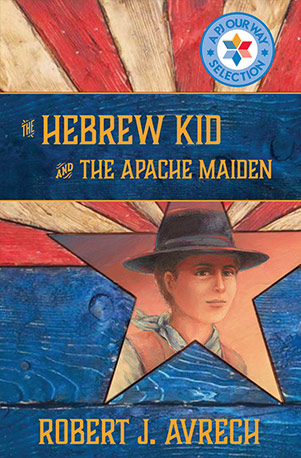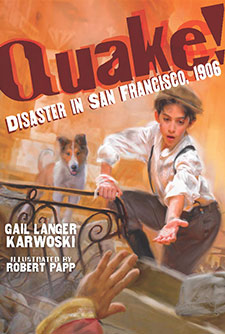The Hebrew Kid and the Apache Maiden
Alone in dangerous Apache territory, Ariel fears for his family’s survival. Then he meets Lozen, sister of the fearsome Apache warrior Victorio, and Ariel discovers that help can sometimes come from the most unlikely places.
Average Rating
( hint: Login to leave a review! )
36 Reviews
Leave Review
What the Book is About
Jewish Content & Values
Positive Role Models
Content Advisory
Talk it Over!
More for You
What the Book is About
This is the adventurous story of Ariel Isaacson and his family, who journey from their Russian shtetl (Yiddish for a small Eastern European town with a large Jewish population) to the post-Civil War Wild West. After being forced to move numerous times, they find themselves in the territory of the legendary and feared Apache. In a surprising turn of events, Ariel befriends Lozen, the sister of the Apache chief, Victorio. Ariel and Lozen share their feelings and fears with each other and learn a deep respect for the other’s religion and culture. The book closes with the culmination of Ariel’s dream: a bar mitzvah (Jewish coming of age ritual for a boy) with his family and closest friends, which include Victorio, Lozen, Doc Holliday (a deadly gunfighter turned friend), and a cobbled together minyan (prayer quorum) from Tombstone, Arizona.
Jewish Content & Values
- Torah knowledge and real-world practicality: Ariel stays strong in his Jewish faith by holding onto his family’s traditions and deep commitment to Torah observance, but he also learns from the world around him, including the ways of the Apaches.
- The power of respect: In contrast with the homesteaders that chase the Isaacsons out of town, Ariel and Lozen are open to people who are different than themselves. They are eager to learn about each other’s religion and culture, but take care in explaining their own firmly held beliefs and perspectives.
Positive Role Models
- Ariel: Soon-to-be-thirteen Ariel shows maturity beyond his years. He wants to believe in his father’s mystical dreams, but is also driven by his mother’s unshakable practicality. In many ways, Ariel becomes the guiding force of the family, making decisions and promises that will change their lives forever.
- Lozen: At first, Lozen is cold and fierce, but soon she warms up to Ariel and his family. She can’t help but be curious about these people whose skin is white and whose Jewish customs are totally unknown to her. She approaches the family’s Judaism and beliefs with great respect and tolerance.
Content Advisory
- While the writing is very accessible, and the pace is adventurous, this book has some disturbing scenes that are more appropriate for older readers (11+).
- Lark Ellen, who Ariel’s family takes in after she suffers an extremely difficult labor and birth, dies from bleeding. As Lark Ellen dies, she makes Ariel promise to raise her son in the Jewish faith. Her death is described poignantly, but also graphically.
- In a moderately graphic scene, Ariel, Lozen, and the Apache soldiers fight with mercenary scalpers who have kidnapped Ariel’s sister.
- The story is peppered with Yiddish terms, which are explained in a glossary in the back. Some terms (which were used freely at that time) are considered offensive today, like shiksa (a non-Jewish woman) and goyim (non-Jews, literally “nations”).
Talk it Over!
- Interfaith dialogue: Ariel and Lozen engage in open discussions about their faiths and beliefs. Have you ever had this kind of discussion with friends? If so, what was it like? If not, would you feel comfortable talking about religion with others?
- Making difficult promises: Lark Ellen’s dying wish is for Ariel to promise that he and his family will raise her baby son in the Jewish faith. That’s a difficult promise for a twelve year-old to make. How would you respond to that kind of request? Has a friend or family member ever asked you to promise to do something that was difficult? How did you respond and how did you feel about it?
More for You
Lamedvavniks: Ariel’s father has a hard time settling down because he is on a quixotic quest to find a lamedvavnik -- a word which stems from Hebrew numerology, where Hebrew letters have numerical values and the letter ל equals 36. According to Jewish legend, there are 36 perfect and righteous people roaming the earth. By virtue of their good deeds, these 36 people keep the world going, but their identity is a secret, sometimes even to themselves.
What the Book is About
What the Book is About
This is the adventurous story of Ariel Isaacson and his family, who journey from their Russian shtetl (Yiddish for a small Eastern European town with a large Jewish population) to the post-Civil War Wild West. After being forced to move numerous times, they find themselves in the territory of the legendary and feared Apache. In a surprising turn of events, Ariel befriends Lozen, the sister of the Apache chief, Victorio. Ariel and Lozen share their feelings and fears with each other and learn a deep respect for the other’s religion and culture. The book closes with the culmination of Ariel’s dream: a bar mitzvah (Jewish coming of age ritual for a boy) with his family and closest friends, which include Victorio, Lozen, Doc Holliday (a deadly gunfighter turned friend), and a cobbled together minyan (prayer quorum) from Tombstone, Arizona.
Jewish Content & Values
Jewish Content & Values
- Torah knowledge and real-world practicality: Ariel stays strong in his Jewish faith by holding onto his family’s traditions and deep commitment to Torah observance, but he also learns from the world around him, including the ways of the Apaches.
- The power of respect: In contrast with the homesteaders that chase the Isaacsons out of town, Ariel and Lozen are open to people who are different than themselves. They are eager to learn about each other’s religion and culture, but take care in explaining their own firmly held beliefs and perspectives.
Positive Role Models
Positive Role Models
- Ariel: Soon-to-be-thirteen Ariel shows maturity beyond his years. He wants to believe in his father’s mystical dreams, but is also driven by his mother’s unshakable practicality. In many ways, Ariel becomes the guiding force of the family, making decisions and promises that will change their lives forever.
- Lozen: At first, Lozen is cold and fierce, but soon she warms up to Ariel and his family. She can’t help but be curious about these people whose skin is white and whose Jewish customs are totally unknown to her. She approaches the family’s Judaism and beliefs with great respect and tolerance.
Content Advisory
Content Advisory
- While the writing is very accessible, and the pace is adventurous, this book has some disturbing scenes that are more appropriate for older readers (11+).
- Lark Ellen, who Ariel’s family takes in after she suffers an extremely difficult labor and birth, dies from bleeding. As Lark Ellen dies, she makes Ariel promise to raise her son in the Jewish faith. Her death is described poignantly, but also graphically.
- In a moderately graphic scene, Ariel, Lozen, and the Apache soldiers fight with mercenary scalpers who have kidnapped Ariel’s sister.
- The story is peppered with Yiddish terms, which are explained in a glossary in the back. Some terms (which were used freely at that time) are considered offensive today, like shiksa (a non-Jewish woman) and goyim (non-Jews, literally “nations”).
Talk it Over!
Talk it Over!
- Interfaith dialogue: Ariel and Lozen engage in open discussions about their faiths and beliefs. Have you ever had this kind of discussion with friends? If so, what was it like? If not, would you feel comfortable talking about religion with others?
- Making difficult promises: Lark Ellen’s dying wish is for Ariel to promise that he and his family will raise her baby son in the Jewish faith. That’s a difficult promise for a twelve year-old to make. How would you respond to that kind of request? Has a friend or family member ever asked you to promise to do something that was difficult? How did you respond and how did you feel about it?
More for You
More for You
Lamedvavniks: Ariel’s father has a hard time settling down because he is on a quixotic quest to find a lamedvavnik -- a word which stems from Hebrew numerology, where Hebrew letters have numerical values and the letter ל equals 36. According to Jewish legend, there are 36 perfect and righteous people roaming the earth. By virtue of their good deeds, these 36 people keep the world going, but their identity is a secret, sometimes even to themselves.


